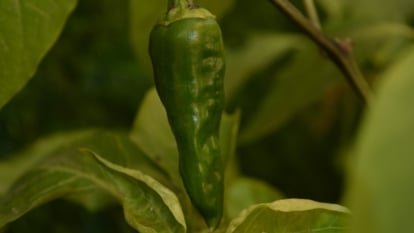Each crop carries its own set of guidelines. With thousands of gardeners advising different techniques, you may wonder which one is right for you. Fear not, as we cover everything you need to know about pepper pruning and let you decide what’s best for your plants.
Pruning your pepper plants leads to different outcomes depending on the season. Early-season, fall, and harvest pruning are three types that help plants produce large crops. These three methods lead to increased harvests by tricking the plants into growing more fruit than normal and allowing more light to reach ripening peppers.
Factors like your climate, USDA growing zone, and how you start your peppers help determine if you need to prune your plants or leave them be. Growers with warm temperatures all year may not need to prune, as plants grow in these regions perennially. Simply prune to shape each year and let them thrive in their perpetual summer.
Gardeners in cold zones with winter freezes may want to snip their peppers, especially during harvest for a large crop. Read on to determine if your chile peppers will benefit from pruning or if you should leave them be this year.
Should I Prune My Pepper Plants?
From serranos to jalapeños, chile peppers vary widely depending on their variety. Some are perky and upright, while others are bushy and sprawling at maturity. In addition to bolstering harvest amounts, pruning gives you control over the plant’s shape.
Let’s say you’re growing the ‘Aji Dulce’ variety. The fruit grows on a large, squat, multistemmed plant. To allow more light to reach the bottom of the plant, I may prune some of the leaves on the topmost parts of the stems. I can also prune select branches and maintain a central leader to create a more upright shape on this bushy plant.
Other varieties like ‘Early Jalapeño’ are upright growers. Pruning can make them bushy and help increase their production.
One major tip is to avoid pruning seedlings with less than four leaves because they’re actively gathering resources to survive. This is especially important when you start from seeds, as you’ll see them in each life stage. Nursery-bought transplants are typically a good size already when they’re available. Prune them as needed.
To help determine whether you should prune, first identify the varieties you like to grow and determine what shape they form. Then, decide if you’d like them to be another shape, and if they need help ripening their fruits.
Benefits

Pruning benefits the plant by directing its growth elsewhere. Take a single-stemmed plant and pinch the top part of the stem off. This process, known as “topping,” instructs the plant to grow two stems where one existed. This leads to a bushy plant with many short stems. Your mature plant with many branches can hold more fruit than it would if unpruned.
Later in the season when your peppers are ripening, pruning helps speed up this process. The fruits, like tomatoes, require light and heat to ripen properly. Let’s say the fruits lie underneath the lush foliage your plants produce. Snip a few of the topmost leaves off and let light reach the inner parts of the bush. This helps the crop ripen quickly, because they’ll have full access to sunlight.
A final benefit of pruning is letting your plant know it’s time to stop growing. As fall and winter approach, cool temperatures and early freezes threaten the ripening fruit on your plants. A final hard pruning during the fall tricks your plant into putting all its efforts into fruit ripening rather than leaf, stem, or root formation.
Drawbacks
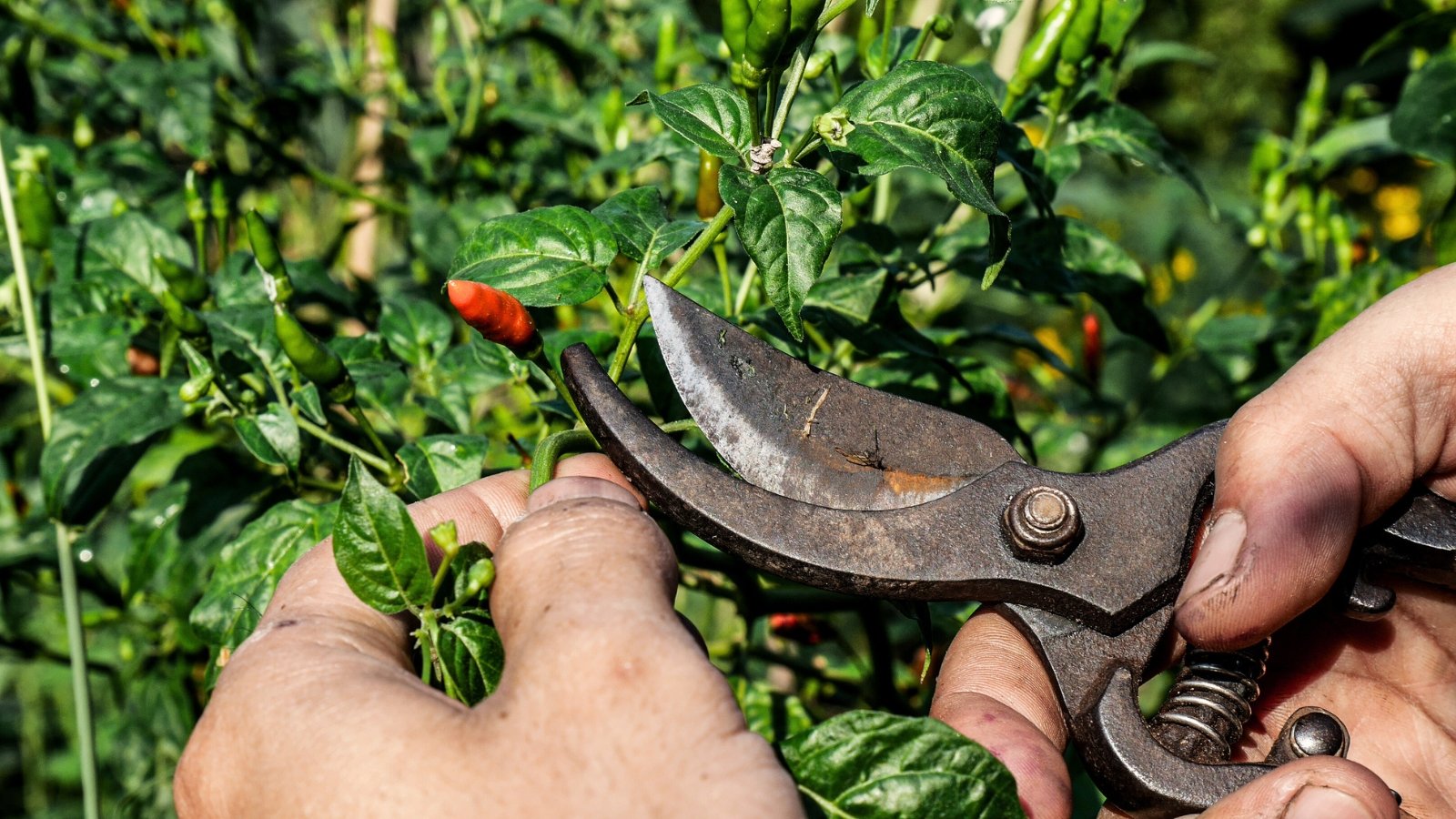
Sometimes, pruning does more harm than good. Gardeners with short growing seasons may want to reconsider their pruning habits. These are long-season crops; they require a consistently warm growing season throughout spring, summer, and fall.
Gardeners with short growing seasons threaten their harvest with pruning, as their plants don’t have time to recover from being snipped. Top pruning, shoot pinching, and any other activity that prunes established plants makes them expend energy to repair themselves.
The repair process has lots of time to finish in areas with long growing seasons. It is only a drawback for short-season growers. Consider holding off on pruning if pepper plants yield little fruit in your area or your warm season is shorter than three months.
You Decide
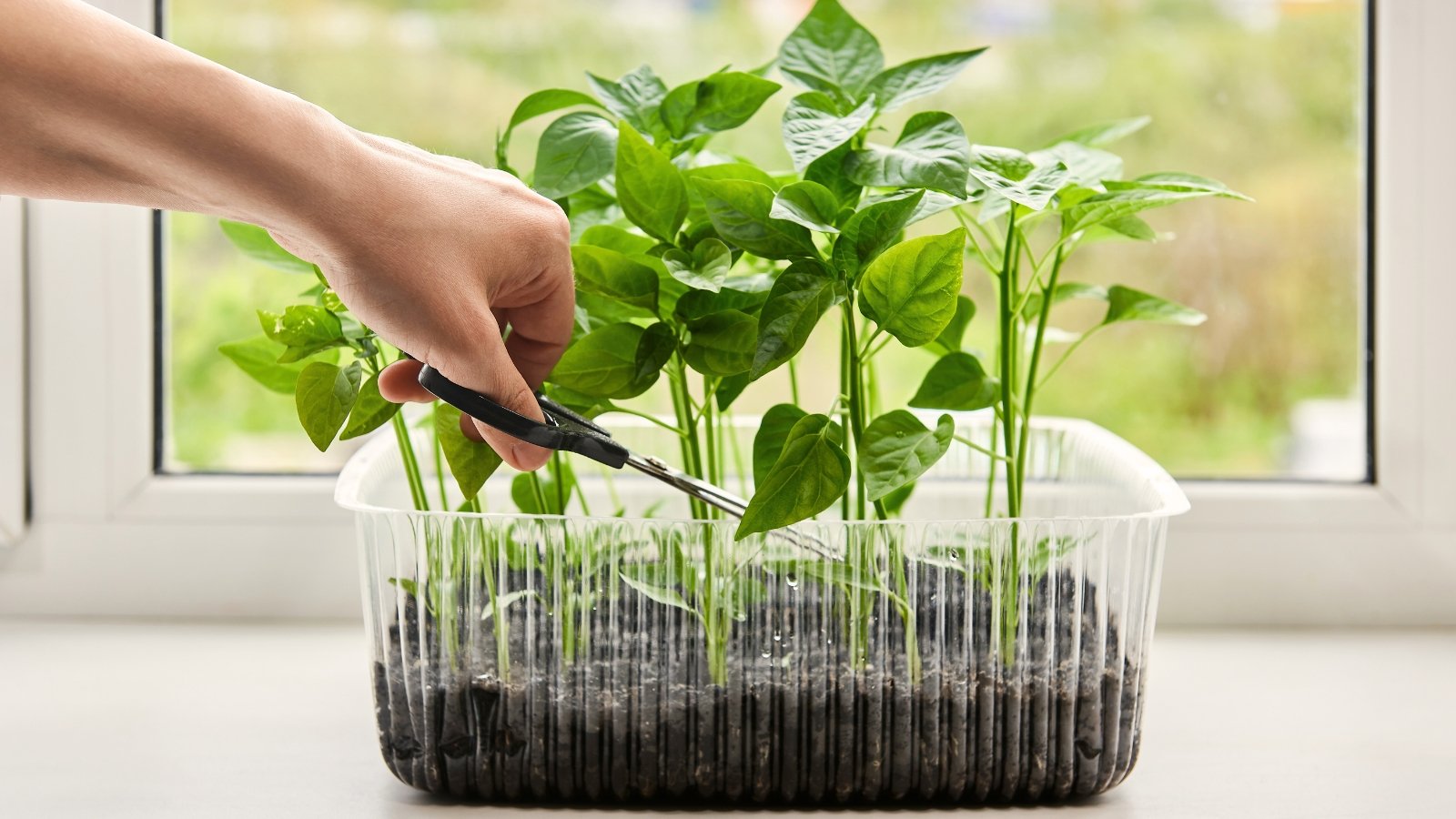
Should you prune? The answer depends on your environment, your varieties, and how long your growing season is.
Here’s a quick guide to help you decide what’s the best route forward:
Prune:
- To ease transplanting stress
- To make a tall variety bushier and more productive
- To speed up ripening
- If your area’s growing season is longer than three months
Avoid Extensive Pruning:
- In areas with cool, wet summers
- On naturally bushy pepper plants
- If your area’s growing season is shorter than three months
Decide what’s best for your baby peppers by considering these factors. I grow them in USDA- growing-zone eight and routinely pinch and prune my plants as needed. Most growers from zones four and above can prune their plants without issues. If you’re still unsure, keep reading and discover how pruning affects plants depending on the season.
How to Prune
Unlike other crops like basil and lettuce, you can’t harvest or prune peppers easily with your fingers. You’ll need something that slices through thick stems with little resistance. Tools like herbal snips, pruners, or similar types allow easy harvesting without damage to your peppers.
Tools
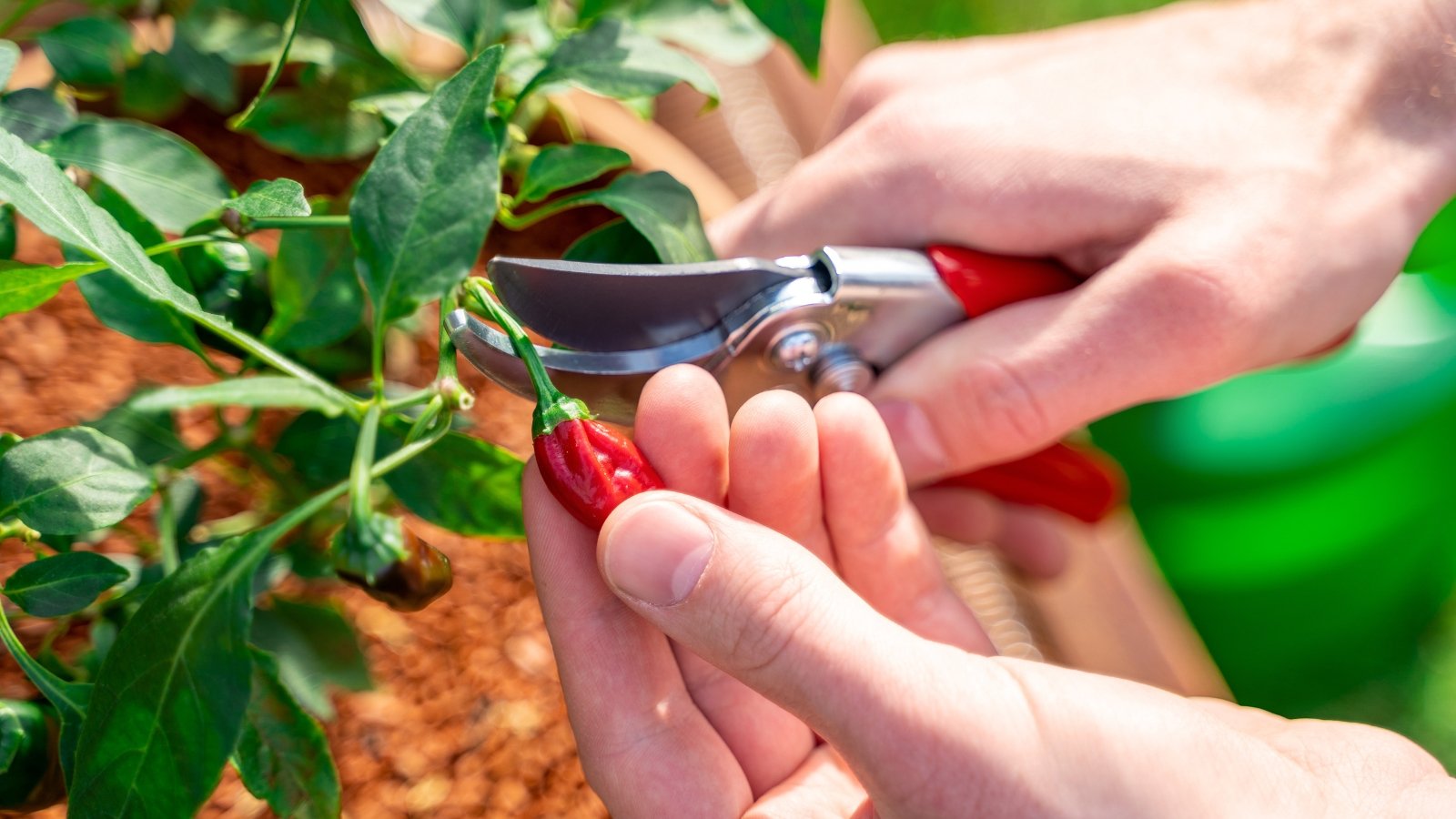
Small stemmed varieties like ‘Santaka’ are easily cut with tools like harvesting snips. Cut their thin stems and small peppers off as needed.
Thicker varieties like ‘Pimiento’ and ‘Orange Sun’ grow vigorous stems that need a stronger tool to penetrate. I use my hand pruner to cut these varieties. The same tool that helps me prune trees also works well with thick-stemmed cultivars.
A hand pruner also works well during harvest if you decide on hard pruning. After an entire growing season getting thick and strong, pepper plants are tough to chop during the fall. A sharp, well-cared-for hand pruner gets the job done without any issues.
Techniques
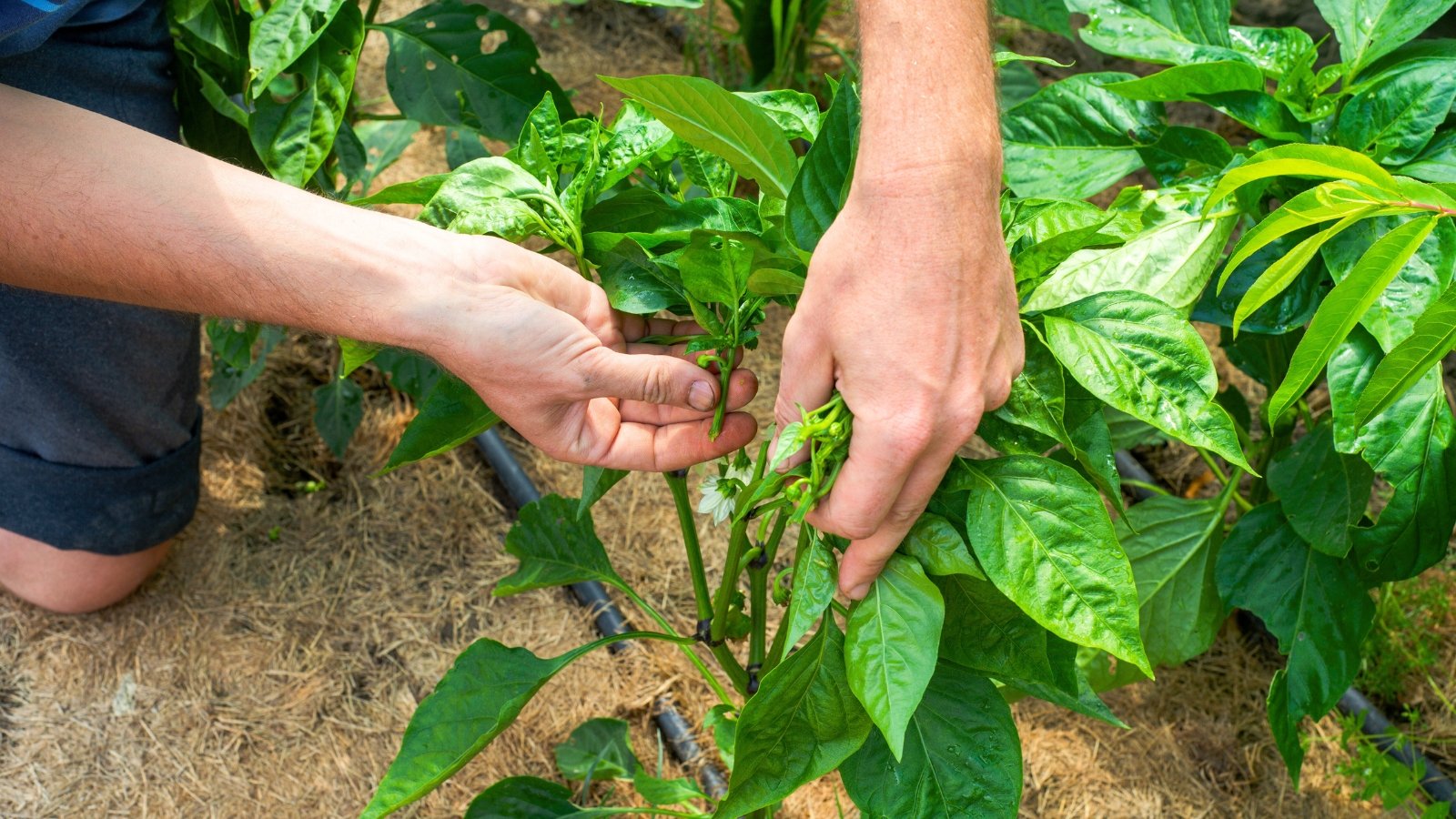
Two techniques stand out as essential methods for pruning. They are pinching and slicing, and they each have different purposes.
Pinching works best on new top growth and during transplanting. Simply use your thumb and index finger to “pinch” off the fleshy new growth. This works well on newer shoots and leaves before their stems thicken.
For chopping thicker stems, use a hand pruner. Slice above a growth point along the main stem, ensuring new shoots sprout on each side. Harvest fruits by pruning them off with a little stem attached. Use caution and avoid snipping off unripened fruits, flowers, and leaves.
When to Prune
The time you prune affects pepper growth differently depending on the season. Pinch top shoots and leaves during transplanting, and use the other types of pruning later in the season.
At Transplanting
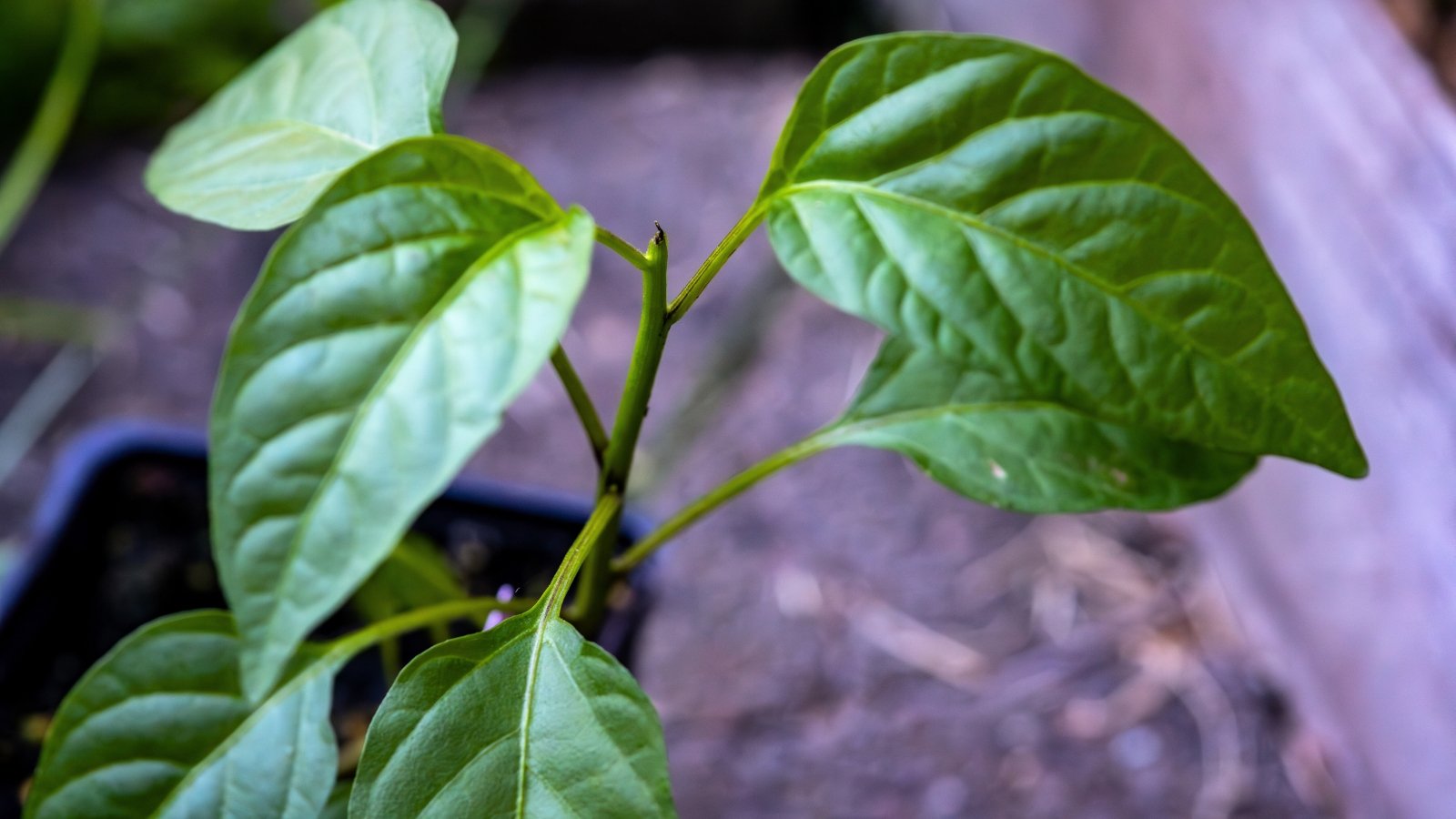
Whether you garden in a short or long growing season, a bit of pruning helps plants acclimate to their new surroundings. Skip this step if you plant seeds in the ground and do not intend to transplant mature peppers.
Most North American gardeners must start seeds indoors or buy mature plants from nurseries and online retailers. This allows a jump start on the growing season and helps peppers produce large harvests come autumn. It also means some care will help mature plants adapt to their new home.
During transplanting, dump the pepper out of its pot and analyze the roots. If they are circling, reaching upwards in their pot, or are crowded, slice off the lowest parts of the roots. This stimulates new growth and helps their roots anchor to the soil.
After slicing their roots off, pepper plants now have less access to nutrients and water than they did in their pots. To help them transition, prune a few leaves off the plant. A good rule of thumb is to prune no more than a third of the total plant. With fewer leaves, your peppers sprout roots easily—eventually, they’ll push new growth out of their stems.
I mentioned another pruning activity called “topping.” This process removes the tips of the tallest stems by pinching them off to spur lateral growth on side shoots. With age, topped varieties grow to be bushy, dense plants full of peppers. Top your plants at transplanting to ease transplant shock and help create productive adult specimens. Avoid this step if you garden in a short growing season, and only snip off leaves as needed to avoid transplant stress.
Summer
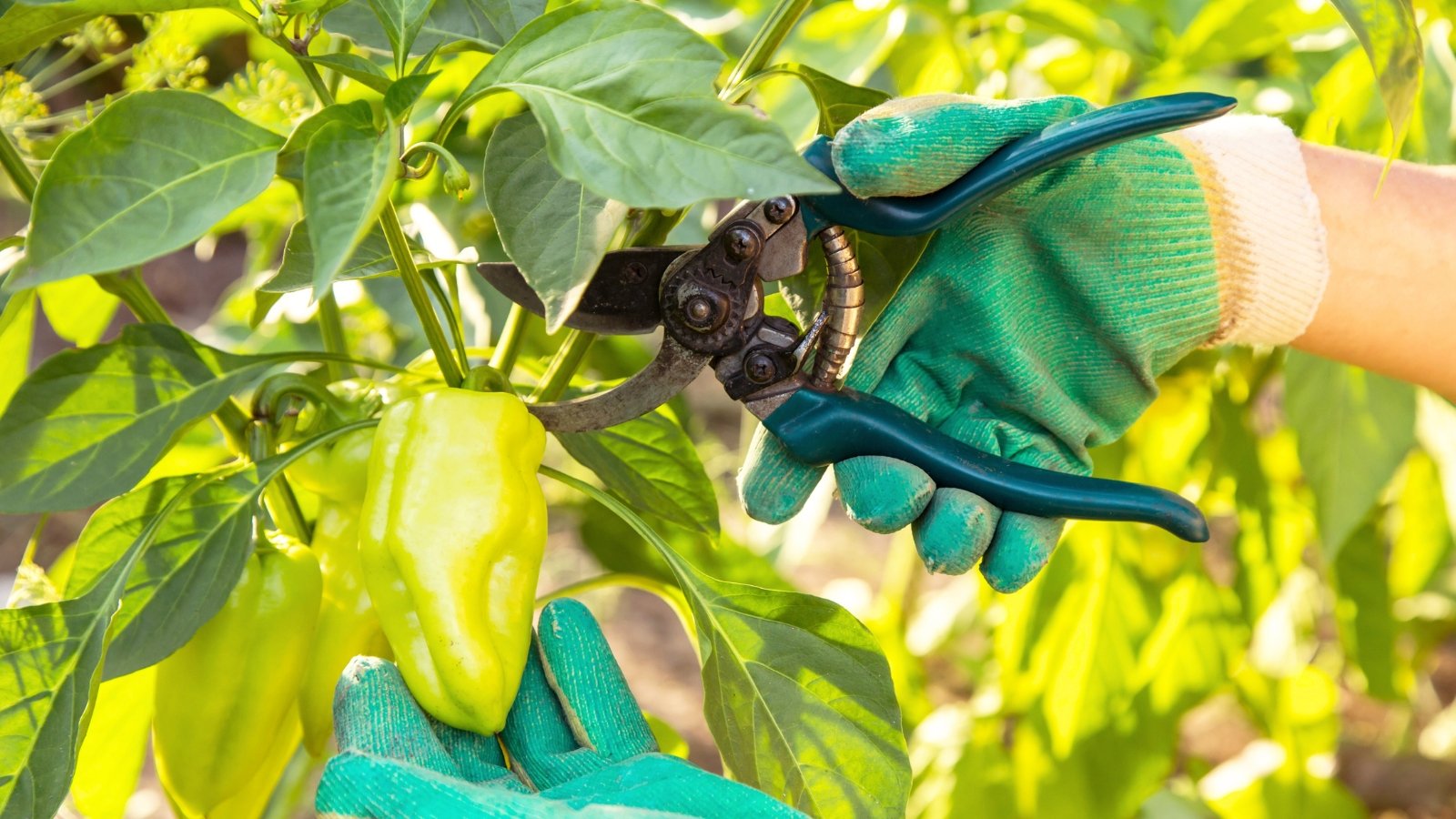
A little goes a long way when it comes to pepper maintenance in summer. They’re actively growing flowers, fruits, and new shoots. This lush growth sometimes crowds out unripe peppers growing toward the center of the plant.
Crowded plants need a little leaf snipping to continue ripening their fruit. Consider the same rule from above, and cut no more than a third of the plant’s total leaves. Select leaves for slicing that block direct sunlight from reaching the interior—these are typically the outermost leaves on the top and sides.
If you garden with a short growing season, determine if pruning will set your plants back too far. Snipping off leaves means the plant produces fewer sugars and has less energy until it grows more leaves. Some slight pruning in these areas is okay, although extensive leaf removal may harm production at the end of the season.
During Harvest
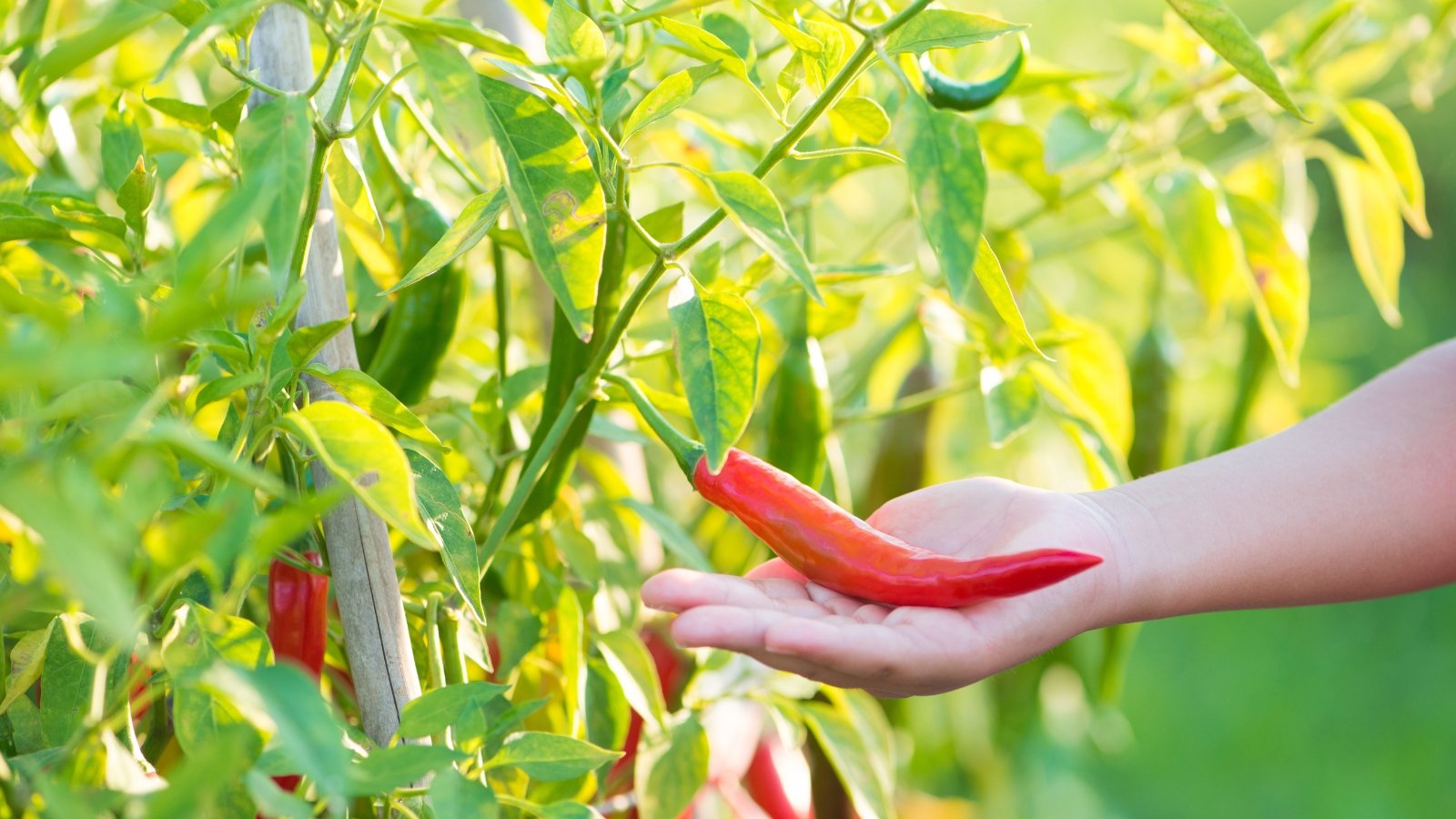
It’s now fall. Long days, warm nights, and consistent sunlight slowly disappear, and your pepper plants notice! They’ll keep growing until a frost comes and stops them in their tracks. Help them know where to direct their energy by hard pruning their stems.
Hard pruning means cutting leaves, stems, and flowers so pepper plants divert their remaining resources towards fruit ripening. Achieve this by pruning off any excess stems and leaves. Cut stems to where peppers are still ripening, and leave one-third of the leaves on the stems. Slice off any flowers and new shoots.
Growers in short or long growing seasons should hard-prune during harvesting if they feel it’s necessary. I recommend leaving infected, struggling, or pest-covered plants alone, as a hard prune may harm their chances of recovery.
Monitor your peppers and pick them as soon as they start changing color. The danger in autumn lies in the cool temperatures and wet conditions that cause fungi and bacteria to infect forming fruits on the plant. With a little color already, your chile peppers can ripen safely in the kitchen near a bright window.
Frequently Asked Questions
Gardeners in zones four and below should only prune during transplanting and harvest. Snip a few leaves and roots off as you transplant to avoid shocking the peppers. During harvest, a hard prune may benefit your peppers by allowing them to ripen quickly. Avoid topping and summer pruning if you garden with a short season.
No! Some varieties are naturally productive and bushy, like ‘Shishito.’ Bell peppers typically grow on a thick stem—pinching it at transplanting helps create bushy plants later on.
Topping, pinching, and a typical pruning cut are the common methods for managing pepper plants. Topping when transplanting creates productive, dense adult plants. Use your hands to pinch tender growth and pruners for proper cuts.
Final Thoughts
I love pruning my pepper plants, especially to help them grow big and strong during their lifetime. In your garden, you are the ultimate decision-maker. Experiment this season with some pruning on a few select plants and see what you think when it’s time for harvest. You may be surprised by the amount of peppers you get!





